|
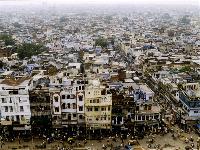
The first day, after a 7½ hour flight, we landed in India's capitol New
Delhi. This city is very, let's say tremendously crowded. But
Delhi is also very different and thus beautiful to be.
This is a picture of Delhi that I took from the top of a minaret at the
Jami Mahid mosque. This is the largest mosque of India. |
|
|
|
|

Near Delhi's Red Fort there was a fair. This was fun, due to the strange
fairground attractions. Since I am good
insured (see USA tour) I even went
into the big wheel (and still live in one piece)!
On the background you can see the stone wall of the Red Fort. |
|
|
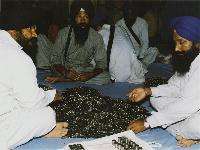
Not far from the Red Fort there is Gurdwara Sisganj, a Sikh temple. You
can get a guided tour here, on your bare feet and with covered hair.
Sikh take care of their community by providing food, medical care and
education for everybody who joins them. They fund all these with all the
gifts they receive. Several men are counting the donated money, on the
above picture. |
 |
|
|
|
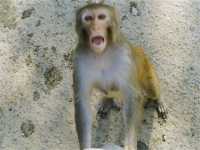
Monkeys are cool as long as they are in their cage. Some monkeys get
pretty upset when you intend to take a picture of them, but then decide
not to. Like this one for instance.
She probably felt rejected when I walked away. So she came after me and
clutched my trouser leg and wouldn't let go. She tried to steel my camera,
but didn't succeed. Then after all I decided to take this picture, just to
get rid of her. See here the result ... a very, very angry
monkey! |
|
|
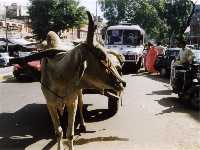
Jaipur is a very nice city where streets are crowded with everything that
has legs. Cows are holy (like everywhere else in the East) and they surely
know that.
But some cows are not considered as real cows, like this unfortunate
bastard! Now he'll have to spend his life pulling wagons, with a rope
through his nose. |
|
|
|
|
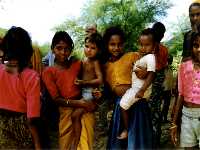
Near Jaipur are some villages where life is quiet and peaceful. People
earn their living by farming. We rode to some villages on the back of a camel.
And here I took these pictures of very kind people. |
|
|

A small child in one of the villages is very photogenic. In fact this one
could be a postcard ...
... or a wallpaper, of course! |
|
|
|
|
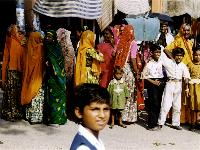
These women in the street of Jaipur, are very shy to pose on a photograph.
I am not sure if it has got anything to do with their religion.
Anyway, they remain a very colorful group that'll do very well in a photo
collection like this. |
|
|
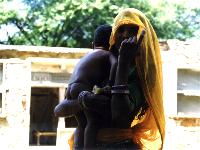
This beautiful woman is also very shy. But with an exposure of a 2000th
of a second, she cannot be shy enough for my camera! |
 |
|
|
|

Fatehpur Sikri was the capital of the Mughal Empire between 1571 and 1585
AD, that is built by hand out of stone.
We got a tour through this marvelous place. It is very well
preserved, thanks to the good weather conditions and the Indian locals. |
|
|
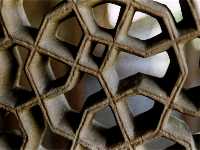
Here is a close up of a wall in Fatehpur Sikri. Imagine how people use
hammer and chisel and created these shapes out of red sandstone plates,
over 4 centuries ago. |
|
|
|
 |

Very nearby Fatehpur Sikri at the Yamuna River is Agra. Although I didn't
like Agra and it's very fanatic Rickshaw drivers, it surely makes your
visit worthwhile. For here is the Taj Mahal!
The Taj is a mausoleum, built in 1632-1648, by Shah Jahan for his
beloved wife Mumtaz Jahan. The white marble building inlaid with gemstones
is regarded as the most outstanding example of Mughal architecture.
Here is a picture that I took during sunrise (around 6 o' clock). |
|
|

This is the only picture that comes from a postcard. It shows the Taj
after rain. |
|
|
|
|
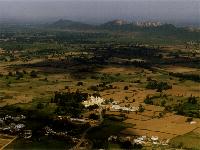
There was a great relief when I had left Agra and arrived in Khajuraho. It
is difficult to drive to Khajuraho, due to the bad conditions of the
road (after the monsoon period). You'd better take an airplane instead. |
|
|
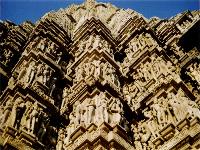
Khajuraho is famous for it's very beautiful and well preserved erotic
temples. Every temple shows a lot of statues of people practicing Kama
Sutra.
The former inhabitants (Chandelas) made sex as a part of their religion.
They believed that they could reach a higher state of consciousness by
practicing sex. |
|
|
|
|

It is amazing that they still found the time to build these marvelous
temples. Anyway, these make sure worthwhile the trouble of getting in and
out of Khajuraho. |
|
|

The last city on our visit in India is Varanasi. The city of Shiva on the
bank of the sacred Ganges is one of the holiest places in India. Hindu
pilgrims come to bathe in the waters of the Ganges, a ritual which washes
away all sinns. It is also a favorite place to die, since expiring here
ensures release from the cycle of rebirths and an instant passport for a
one-way trip to heaven. It's a magical city where the most intimate
rituals of life and death take place in public on the city's famous ghats
(steps which lead down to the river).
The Ganges was exceptionally high during the time I was here. That's why
the ghats are so short on this picture.
|
 |
|